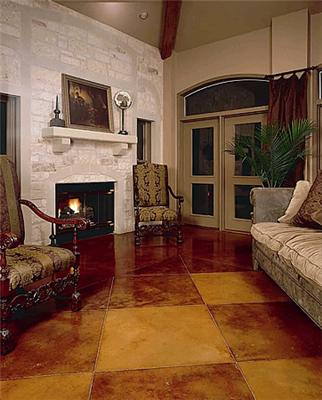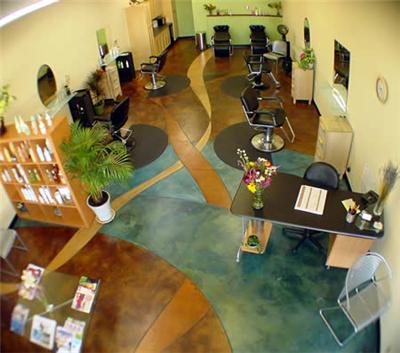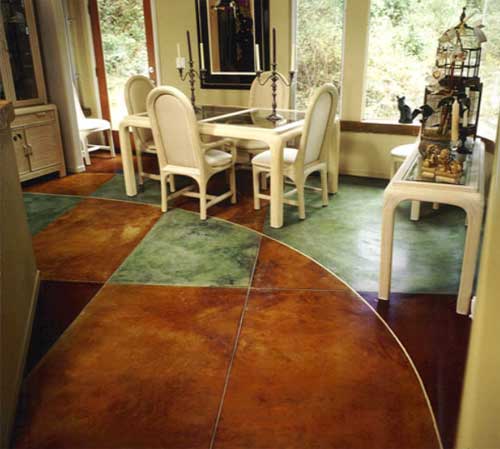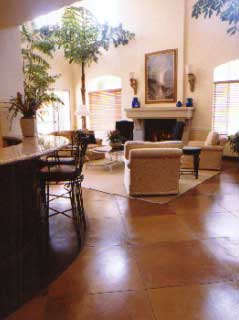Services: Aim Concrete offers a wide range of services for both your interior and exterior concrete and construction needs (please click the blue accordion bars below to see our different services)
Stamped concrete is concrete that is designed to resemble other material such as brick, slate, flagstone, stone, tile or wood.
Stamp concrete is poured in two way: The first method mixes the base color in advance as selected by our cli ents. In the second method the colors are added after the "gray colored" concrete is poured. In both methods, after sufficient amount of time has passed for the concrete to form itself, the concrete is stamped in accordance to the customer's design selection.
ents. In the second method the colors are added after the "gray colored" concrete is poured. In both methods, after sufficient amount of time has passed for the concrete to form itself, the concrete is stamped in accordance to the customer's design selection.
The following depicts some of the more common stamps. You could view a complete list of concrete stamps at www.scofield.com










As one could imagine there are a variety of colors to choose from. The world of cement has come so far from the common gray rough look. For a selection of colors please click here.
In the last twenty years, at Aim Concrete we have poured probably several hundred driveways. But today, the concrete choice has expanded to include a multitude of decorative concrete options. S
 ometimes referred to as colored cement, or painted concrete, the effects that can be achieved with decorative applications can be astounding on a concrete driveway.
ometimes referred to as colored cement, or painted concrete, the effects that can be achieved with decorative applications can be astounding on a concrete driveway.
At Aim Concrete poring your driveway is our bread and butter. Please call us for a chat and free consultation.
Concrete Overlays are becoming increasing popular.  Considering the incredible resilience and innumerable textures and colors, Overlays are the material of choice to decorate existing concrete. Overlay could be placed on top of the existing cement, making t
Considering the incredible resilience and innumerable textures and colors, Overlays are the material of choice to decorate existing concrete. Overlay could be placed on top of the existing cement, making t hem a desirable decorative solution at a very reasonable price to the client.
hem a desirable decorative solution at a very reasonable price to the client.
As with Acid Staining, Overlay requires a "prepared" surface which should be free of large cracks or any loose material. Overlay usually must be place at temp. under the 80 F. for better curing.
Acid stain is not a paint or coating agent, rather, it's a coloring process involving a chemical reaction on a cementation material. A solution made with water, acid and inorganic salts reacts with minerals already present in the concrete, the result of this reaction is color. Acid stain is a very durable product if properly protected with sealer or wax, and it can be applied to both interiors and exteriors.
Acid stains can be applied to new or old, plain or colored concrete surfaces. Several companies manufacture chemical stains that are variations of three basic color groups: black, brown, and blue-green. In general, cements that produce larger amounts of calcium hydroxide during hydration  will show more stain color, and higher cement contents pro-duce more intense colors.
will show more stain color, and higher cement contents pro-duce more intense colors.
One of the most popular ways to achieve color is through acid-staining. Chemical stains can be applied to new or old, plain or colored concrete surfaces. Although they are often called acid stains, acid isn't the ingredient that colors the concrete.
Metallic salts in an acidic, water-based solution react with hydrated lime (calcium hydroxide) in hardened concrete to yield insoluble, colored compounds that become a permanent part of the concrete.
The acid in chemical stains opens the top surface of the concrete, allowing metallic salts to reach the free lime deposits. Water from the stain solution then fuels the reaction, usually for about a month after the stain has been applied. Other factors that affect the outcome include:
* Cement properties and amount
* Admixtures used
* Type of aggregate used
* Concrete finishing methods
* Concrete age and moisture content when stain is applied
* Weather conditions when stain is applied
* Efflorescence
In general, cements that produce larger amounts of calcium hydroxide during hydration show more stain
color; higher cement contents yield more intense colors.
Many homeowners today prefer light tan finishes, which make up about 60 percent of the market. Greens and browns are popular, too. A combination of stain and water, called black washes, can be used to reduce the contrast between colors.




